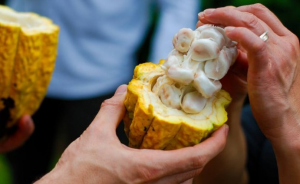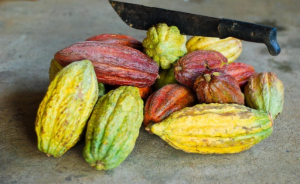Cocoa fruits were used by the Indians of pre-Columbian America, and the scientific name Theobroma cacao, translated from Latin – “food of the gods”, the tree received in the middle of the 18th century from the Swedish naturalist Carl Linnaeus.
Such a pretentious name is easily explained – cocoa beans, according to biologists, contain about 400 substances, most of which have useful, and sometimes even indispensable properties for human health.
WHERE AND HOW COCOA BEANS GROW
Comfortable conditions for the growth of a cocoa tree are high humidity, a hot climate, and the absence of direct sunlight.

Like a vacationer who does not want to burn out, they simply need sun awnings. Usually light-loving banana trees and coconut palms take on this role.
In the second year of life, flowers appear on cocoa trees, from which fruits ripen after 2-3 years. After that, the trees bear fruit for another 20-25 years.
Today, the habitat of wild Theobroma cacao is a narrow belt around the equator: within 10 degrees north and 10 degrees south latitude. And cocoa plantations can be found in Africa, Asia and Latin America.
Absolute leadership in terms of production and export of cocoa belongs to the West African Republic of Côte d’Ivoire. Other major producers are Ghana, Nigeria, Cameroon, Indonesia and Brazil.
There are three main varieties of the cocoa tree:
Criollo (Creollo) – an elite variety, originally from Venezuela. The beans are low in acid, have a pronounced flavor, and have virtually no bitterness. Unfortunately, Criollo trees are the least productive and often prone to disease.
Forastero (Forastero) – originates from the Amazon jungle. It is a stronger type of tree, easy to grow, and the most productive (accounting for about 85% of the world’s cocoa bean production). Most Forastero cultivars have a characteristic cocoa flavor, but they are not aromatic and are partially bitter or sour.

Trinitario (Trinitario) from Trinidad is a hybrid of Criollo and Forastero and combines a number of taste qualities of the former with disease resistance of the latter. Trinitario has a strong but noble aroma with a slight sourness and belongs to the elite varieties.
PROCESSING OF COCOA BEANS
The cocoa fruit consists of a shell and pulp, in which 30-50 small (about 2.5 centimeters in length) almond-shaped bean seeds are located. They have a bitter-tart taste and a pale color.
Ripe fruits are manually removed from the trees, carefully chopped and the precious seeds covered with white pulp are taken out. Then they are put in wooden boxes, covered with banana leaves and left for 5-6 days. During this time, in the process of fermentation (fermentation), the natural bitterness of cocoa beans is eliminated and a characteristic chocolate taste is formed.
cocoa bean inside
After fermentation, the beans are dried in the sun, put in jute bags and sent to factories. There, cocoa liquor, cocoa butter and cocoa powder are made from them.
Cocoa mass and cocoa butter are used as the main component in the production of chocolate and chocolate products, and cocoa powder is widely used in the confectionery, dairy and baking industries.
In addition, some of the components of cocoa fruits are used in pharmaceuticals and cosmetic products.
